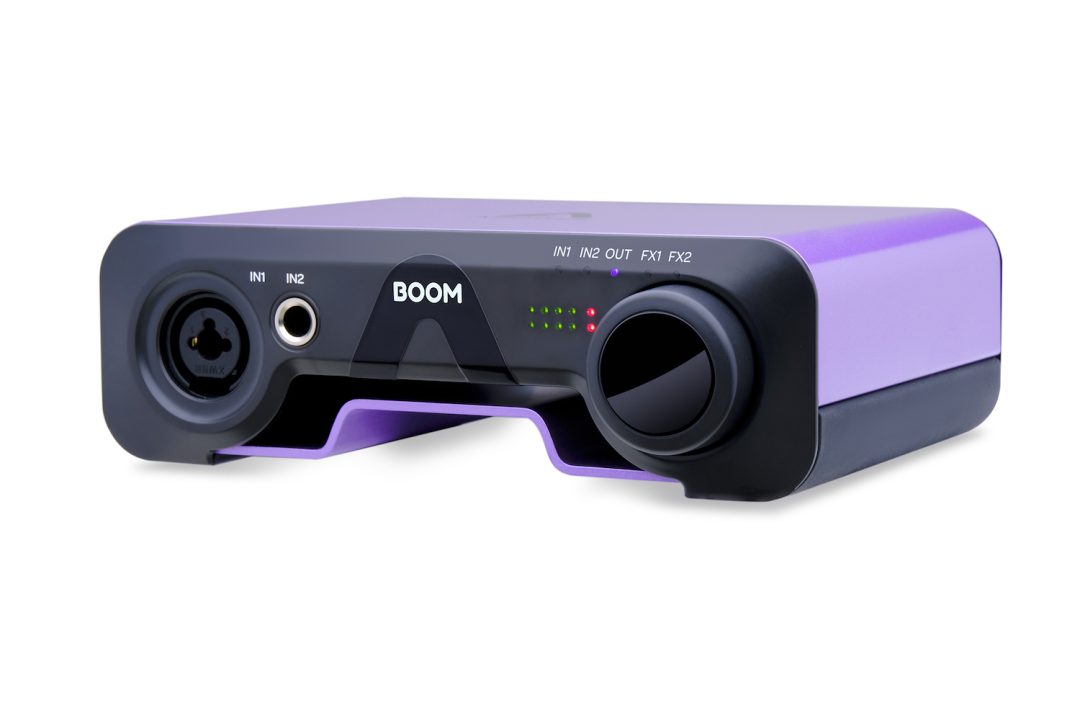With a rich legacy that spans several decades, Apogee has earned a reputation as a trailblazer in multiple sectors, catering to the diverse needs of professionals, creatives, and tech enthusiasts alike. Whether it’s audio interfaces, digital converters, or other top-of-the-line recording equipment, Apogee consistently raises the bar and sets new standards in quality and performance. One such innovation is the new Apogee Boom — an entry-level audio interface with a few interesting embellishments that we’re reviewing.
Elevate Your Audio Experience: Introducing the Apogee Boom
What establishes Apogee as a trusted name is its commitment to precision and meticulous attention to detail. Every product that bears the Apogee name is a testament to the pursuit of perfection, backed by a team of passionate experts who share a passion for music, design, and technology.
- RELATED: Apogee Duet 3 Review | Ultimate Portable Interface?
- RELATED: Apogee Digital, Changing Digital Recording Forever
The Boom is a 2×2 desktop USB-C interface with onboard DSP to power Apogee’s Symphony ECS Channel Strip plugin. This plugin, tuned by the mighty Bob Clearmountain, provides users analog-style recording with drive, EQ, and compression, right at the source.
Apogee Boom Offers Uncompromising Sound Quality & Audio Performance
Apogee audio interfaces as a whole, including the Boom, boast exceptional audio quality, reliability, and seamless integration with professional recording setups. Since the brand’s inception in 1985, Apogee set the standard for conversion quality and hasn’t looked back.
Their audio interfaces utilize advanced analog-to-digital and digital-to-analog converters, providing pristine sound reproduction with minimal distortion and noise. This level of fidelity ensures that recordings maintain the essence and nuance of the original source.
Apogee Boom Review: Should You Be Using This Audio Interface?
Design & Build
You’ll notice straight away that the Apogee Boom is aesthetically striking. The purple and black chassis is a rich, yet subdued, color combination. A large letter “A,” formed partially by an embossed center logo and completed by an entirely separate piece below it, commands attention.
From a design and build perspective, this is not your average “box” audio interface. Apogee made a clever choice to carve out the lower portion of the interface that helps form the “A” logo. In short, it looks incredible.
Compatibility & Features
The Boom is compatible with MacOS 10.15+, Windows 10 Anniversary+, and iOS 15+. Most machines within the last several years should have no problem syncing with this interface.
As far as features go, the Apogee Boom offers a single XLR input, a Hi-Z instrument input, a headphone output, and a pair of monitor outputs. These are the essentials for home recording, music production, and content creation. Mentioned earlier is built-in DSP for low-latency recording using Apogee FX. Included with the bundle is the Symphony ECS Channel Strip to print effects like drive, EQ, and compression in real-time.
User Interface
Apogee streamlined the Boom with a single-knob user interface that selects and controls the various input and output levels. There are a pair of LED indicators displaying gain for inputs 1 and 2. All in all, it’s a simple user interface that’s supposed to be accessible to those who may not be audio professionals.
The real power lies in the free Control 2 software. This offers access to all of the Boom’s features and usability, which is a pro or a con depending on how you look at it.
How Does It Sound?
Like all Apogee products, this interface boasts high-quality preamps and converters. Industry standard is a term that gets bandied about frequently, and it can be somewhat nebulous as more and more companies produce exceptional quality.
In easy words, there should be no concerns about the sound quality with an interface from Apogee. It will no doubt be clean and noise-free for the best, most accurate representation of the source material.
What Strengths Does the Boom Offer?
We just covered it, but the preamp and conversion technology is top-notch. The preamp has up to 62dB of gain on tap, and the converters offer quality up to 24-bit/192 kHz and 100+ dB of dynamic range. Another strength of the Boom interface is onboard DSP and the inclusion of the Symphony channel strip for real-time signal processing. Finally, the headphone output is zero ohm, which means it can drive virtually any pair of headphones with ease.
What Drawbacks Does It Have?
Unfortunately, the Apogee Boom audio interface isn’t perfect. Somewhat inexplicably, plugging in a pair of headphones mutes the monitor outputs; you’ll be plugging and unplugging headphones constantly if you use multiple monitor sources for reference. Not to mention, the headphone jack is on the back of the interface — not the easily accessible front panel.
Additionally, the LED meters, with only five stops, are hard to gauge accurately. You’re much better off setting levels using the Control 2 software. Some users may wonder why they’d need software to control their hardware, and that’s a fair judgment, especially for an “entry-level” interface catering to non-pro users. The fact that Control 2 is almost necessary to access key features, such as loopback for content creators and live streamers, might be a downside for some.
Closing Thoughts: Is the Apogee Boom Right for Your?
In review, the Apogee Boom is a unique addition to the densely populated 2×2 interface market. Class-leading preamp and converter technology is a nice draw, as is DSP and a printable channel strip plugin. Overall, this is a deceptively powerful USB-C interface, yet most of the power comes from software. The hardware itself is about as barebones as it gets, at least in terms of I/O. Under the hood, there’s still a lot of tech to love.
